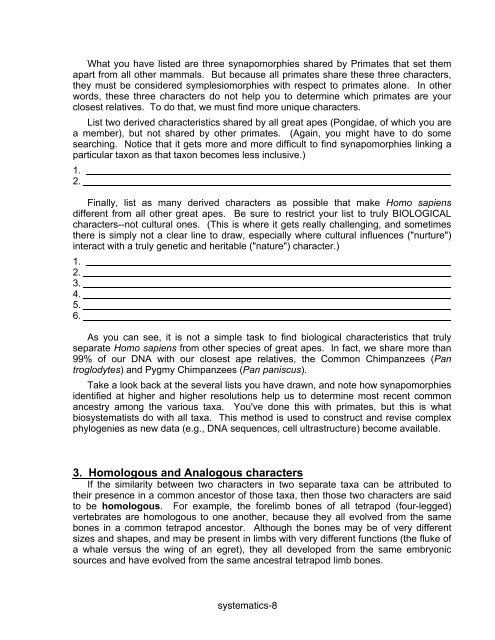Evolution and Biodiversity Laboratory Systematics and Taxonomy I ...
Evolution and Biodiversity Laboratory Systematics and Taxonomy I ...
Evolution and Biodiversity Laboratory Systematics and Taxonomy I ...
Create successful ePaper yourself
Turn your PDF publications into a flip-book with our unique Google optimized e-Paper software.
What you have listed are three synapomorphies shared by Primates that set themapart from all other mammals. But because all primates share these three characters,they must be considered symplesiomorphies with respect to primates alone. In otherwords, these three characters do not help you to determine which primates are yourclosest relatives. To do that, we must find more unique characters.List two derived characteristics shared by all great apes (Pongidae, of which you area member), but not shared by other primates. (Again, you might have to do somesearching. Notice that it gets more <strong>and</strong> more difficult to find synapomorphies linking aparticular taxon as that taxon becomes less inclusive.)1.2.Finally, list as many derived characters as possible that make Homo sapiensdifferent from all other great apes. Be sure to restrict your list to truly BIOLOGICALcharacters--not cultural ones. (This is where it gets really challenging, <strong>and</strong> sometimesthere is simply not a clear line to draw, especially where cultural influences ("nurture")interact with a truly genetic <strong>and</strong> heritable ("nature") character.)1.2.3.4.5.6.As you can see, it is not a simple task to find biological characteristics that trulyseparate Homo sapiens from other species of great apes. In fact, we share more than99% of our DNA with our closest ape relatives, the Common Chimpanzees (Pantroglodytes) <strong>and</strong> Pygmy Chimpanzees (Pan paniscus).Take a look back at the several lists you have drawn, <strong>and</strong> note how synapomorphiesidentified at higher <strong>and</strong> higher resolutions help us to determine most recent commonancestry among the various taxa. You've done this with primates, but this is whatbiosystematists do with all taxa. This method is used to construct <strong>and</strong> revise complexphylogenies as new data (e.g., DNA sequences, cell ultrastructure) become available.3. Homologous <strong>and</strong> Analogous charactersIf the similarity between two characters in two separate taxa can be attributed totheir presence in a common ancestor of those taxa, then those two characters are saidto be homologous. For example, the forelimb bones of all tetrapod (four-legged)vertebrates are homologous to one another, because they all evolved from the samebones in a common tetrapod ancestor. Although the bones may be of very differentsizes <strong>and</strong> shapes, <strong>and</strong> may be present in limbs with very different functions (the fluke ofa whale versus the wing of an egret), they all developed from the same embryonicsources <strong>and</strong> have evolved from the same ancestral tetrapod limb bones.systematics-8
















